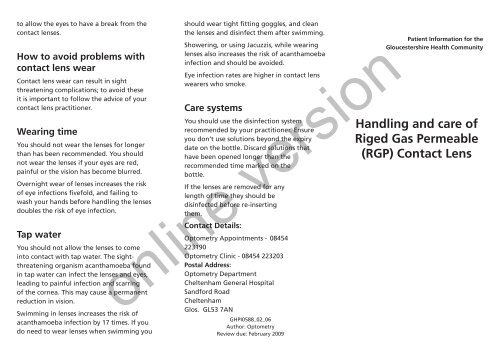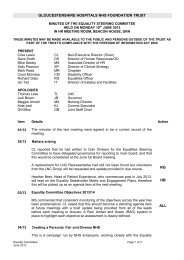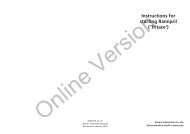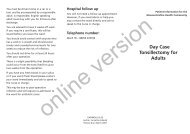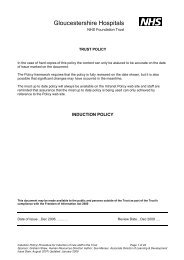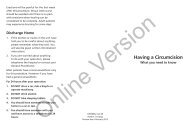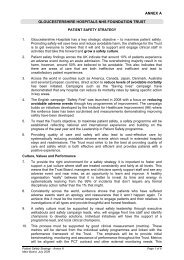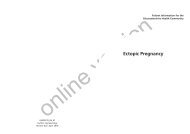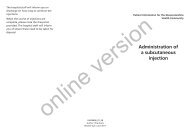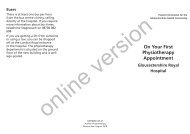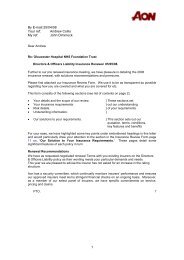Handling and care of Riged Gas Permeable (RGP) Contact Lens
Handling and care of Riged Gas Permeable (RGP) Contact Lens
Handling and care of Riged Gas Permeable (RGP) Contact Lens
You also want an ePaper? Increase the reach of your titles
YUMPU automatically turns print PDFs into web optimized ePapers that Google loves.
to allow the eyes to have a break from the<br />
contact lenses.<br />
How to avoid problems with<br />
contact lens wear<br />
<strong>Contact</strong> lens wear can result in sight<br />
threatening complications; to avoid these<br />
it is important to follow the advice <strong>of</strong> your<br />
contact lens practitioner.<br />
Wearing time<br />
You should not wear the lenses for longer<br />
than has been recommended. You should<br />
not wear the lenses if your eyes are red,<br />
painful or the vision has become blurred.<br />
Overnight wear <strong>of</strong> lenses increases the risk<br />
<strong>of</strong> eye infections fivefold, <strong>and</strong> failing to<br />
wash your h<strong>and</strong>s before h<strong>and</strong>ling the lenses<br />
doubles the risk <strong>of</strong> eye infection.<br />
Tap water<br />
You should not allow the lenses to come<br />
into contact with tap water. The sightthreatening<br />
organism acanthamoeba found<br />
in tap water can infect the lenses <strong>and</strong> eyes,<br />
leading to painful infection <strong>and</strong> scarring<br />
<strong>of</strong> the cornea. This may cause a permanent<br />
reduction in vision.<br />
Swimming in lenses increases the risk <strong>of</strong><br />
acanthamoeba infection by 17 times. If you<br />
do need to wear lenses when swimming you<br />
should wear tight fitting goggles, <strong>and</strong> clean<br />
the lenses <strong>and</strong> disinfect them after swimming.<br />
Showering, or using Jacuzzis, while wearing<br />
lenses also increases the risk <strong>of</strong> acanthamoeba<br />
infection <strong>and</strong> should be avoided.<br />
Eye infection rates are higher in contact lens<br />
wearers who smoke.<br />
Care systems<br />
You should use the disinfection system<br />
recommended by your practitioner. Ensure<br />
you don’t use solutions beyond the expiry<br />
date on the bottle. Discard solutions that<br />
have been opened longer than the<br />
recommended time marked on the<br />
bottle.<br />
If the lenses are removed for any<br />
length <strong>of</strong> time they should be<br />
disinfected before re-inserting<br />
them.<br />
<strong>Contact</strong> Details:<br />
Optometry Appointments - 08454<br />
223190<br />
Optometry Clinic - 08454 223203<br />
Postal Address:<br />
Optometry Department<br />
Cheltenham General Hospital<br />
S<strong>and</strong>ford Road<br />
Cheltenham<br />
Glos. GL53 7AN<br />
online version<br />
GHPI0588_02_06<br />
Author: Optometry<br />
Review due: February 2009<br />
Patient Information for the<br />
Gloucestershire Health Community<br />
<strong>H<strong>and</strong>ling</strong> <strong>and</strong> <strong>care</strong> <strong>of</strong><br />
<strong>Riged</strong> <strong>Gas</strong> <strong>Permeable</strong><br />
(<strong>RGP</strong>) <strong>Contact</strong> <strong>Lens</strong>
Always wash your h<strong>and</strong>s before h<strong>and</strong>ling<br />
your contact lenses.<br />
Insertion<br />
It is usually best to work over a clean white<br />
towel, this makes the lens easier to find if<br />
dropped, <strong>and</strong> prevents damage to the lens.<br />
Place the lens on your index finger, concave<br />
side up.<br />
With the fingers <strong>of</strong> your other h<strong>and</strong> hold the<br />
upper eyelid firmly open, it is <strong>of</strong>ten best to<br />
bring the h<strong>and</strong> from above to give plenty <strong>of</strong><br />
room to get the lens near to the eye.<br />
With the middle finger hold the lower lid<br />
down.<br />
Bring the lens up to the eye <strong>and</strong> place it<br />
gently onto the cornea.<br />
Slowly release the lower lid, <strong>and</strong> then the<br />
upper lid.<br />
Then look to see whether you can see with<br />
the lens, this tells you that it is in the right<br />
place. If the lens has displaced in the eye you<br />
can usually spot it on the white <strong>of</strong> the eye,<br />
or feel for it.<br />
To re-centre the lens you must look in the<br />
opposite direction to the position <strong>of</strong> the<br />
displaced lens, then hold the lens against<br />
the eyeball by pressing through the eyelid,<br />
<strong>and</strong> look slowly back to the lens position,<br />
the lens should re-centre.<br />
If the lens is under the upper lid it may be<br />
necessary to look right down <strong>and</strong> move the<br />
eye side to side, while massaging the top lid<br />
to encourage the lens to drop.<br />
To remove the lens<br />
Look straight ahead, hold the outer edge <strong>of</strong><br />
the eyelids with your index finger, <strong>and</strong> bring<br />
the outer edges up towards the eyebrow,<br />
keeping the eyelids pressed against the<br />
eyeball. Then simultaneously look in the<br />
direction <strong>of</strong> the nose <strong>and</strong> blink.<br />
The lens<br />
should be<br />
dropped onto<br />
a suitable<br />
surface.<br />
Sometimes the<br />
lens falls onto<br />
the lashes.<br />
online version<br />
Another method <strong>of</strong> removal<br />
Using both index fingers, place one on the<br />
upper lid <strong>and</strong> the other on the lower lid<br />
close to the lid margin, pull both lids apart<br />
<strong>and</strong> then push the lids together, keeping the<br />
lids tight against the eyeball throughout.<br />
Cleaning<br />
<strong>Lens</strong>es should be cleaned immediately on<br />
removal from the eye.<br />
A drop <strong>of</strong> a suitable gas permeable lens<br />
cleaner should be placed into the lens <strong>and</strong><br />
the lens should be rubbed on the palm <strong>of</strong><br />
the h<strong>and</strong> for 15 seconds or so, then the lens<br />
should be rubbed between finger <strong>and</strong> thumb<br />
for a few seconds.<br />
The lens should be thoroughly rinsed with<br />
saline <strong>and</strong> stored in its case with fresh<br />
wetting <strong>and</strong> soaking (conditioning) solution.<br />
The lens case should be rinsed with fresh<br />
disinfecting solution, <strong>and</strong> left open in the air<br />
to dry when the lenses are being worn, <strong>and</strong><br />
should be thoroughly washed out once a<br />
week, <strong>and</strong> cleaned with a cotton wool bud.<br />
Regular replacement <strong>of</strong> lens cases is essential<br />
to trouble free contact lens wear, ideally with<br />
each purchase <strong>of</strong> fresh solution.<br />
If your eyes become red, sore, or the vision<br />
is blurred stop wearing the lenses. If they<br />
do not return to normal overnight, or you<br />
notice a discharge from the eyes you should<br />
contact your GP, contact lens practitioner, or<br />
the Hospital.<br />
If you are prescribed drops or ointment you<br />
can resume lens wear after the course <strong>of</strong><br />
treatment: consult your ophthalmologist or<br />
optometrist.<br />
It is advisable to have a pair <strong>of</strong> spectacles that<br />
can be worn in case <strong>of</strong> eye infections, <strong>and</strong>


